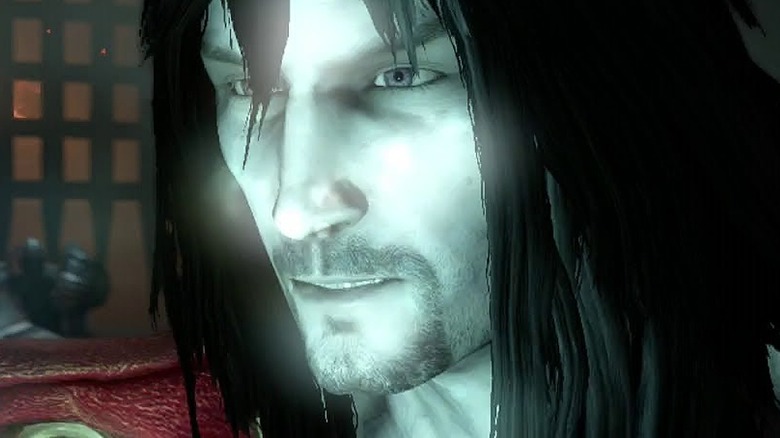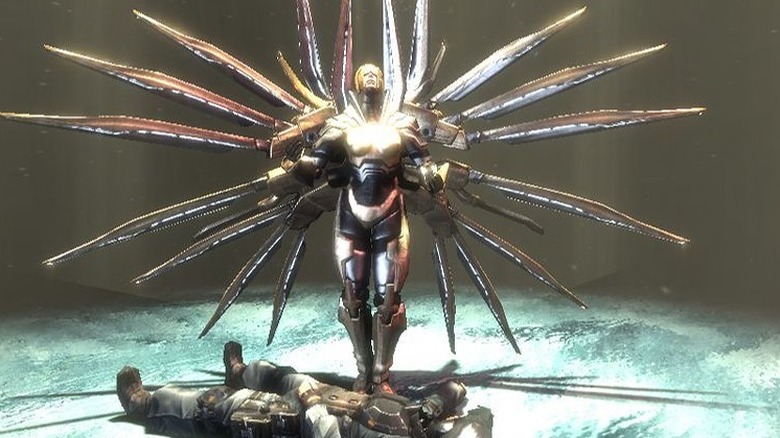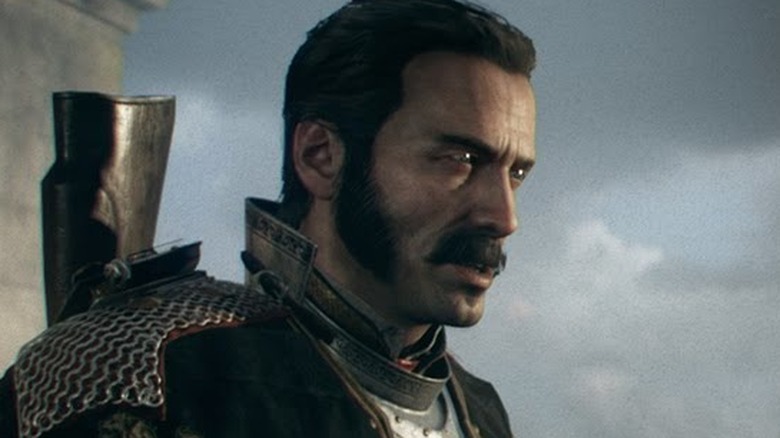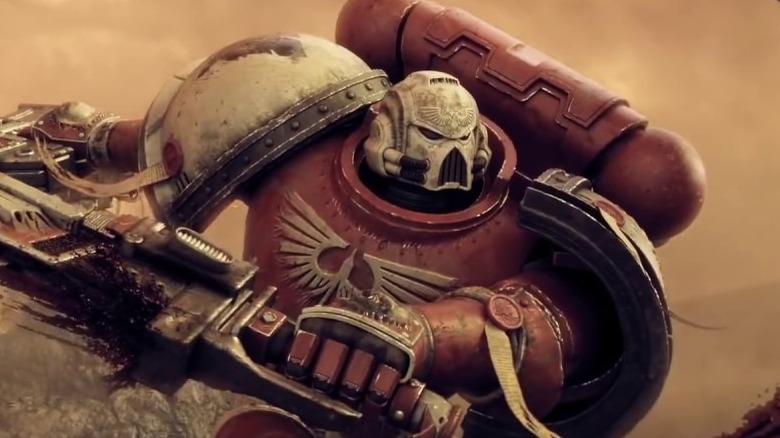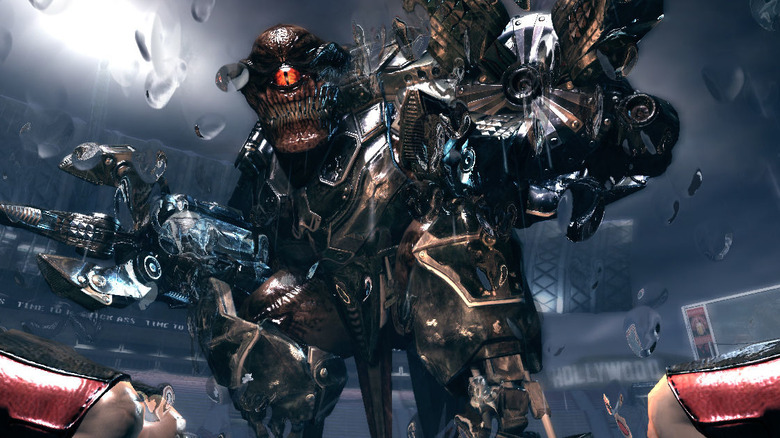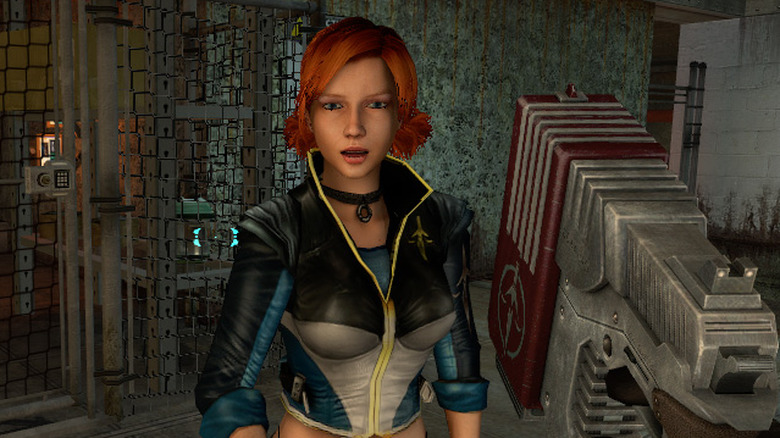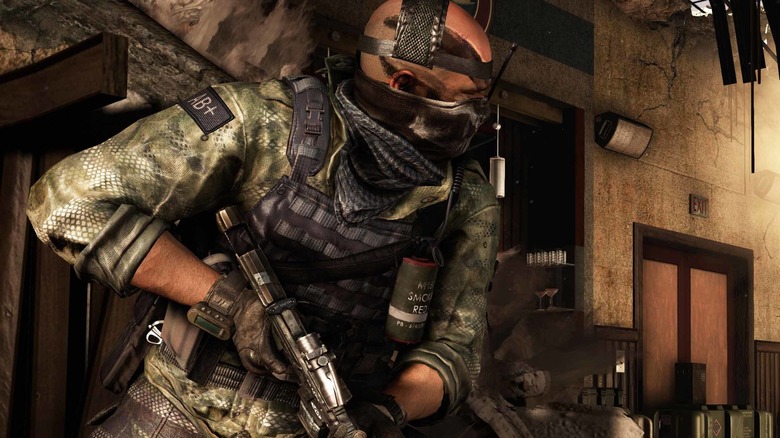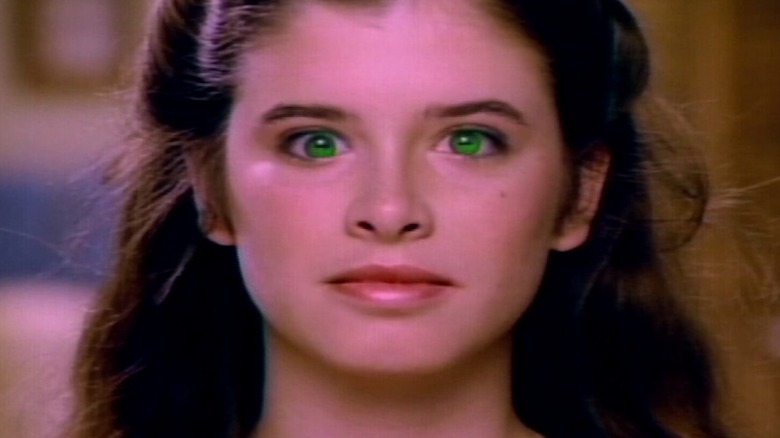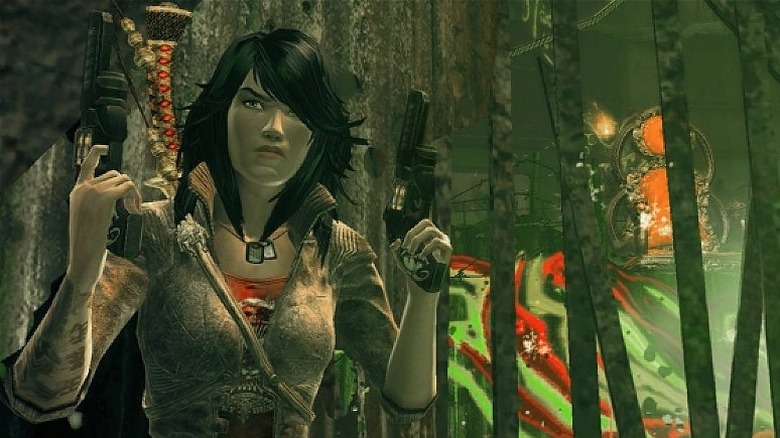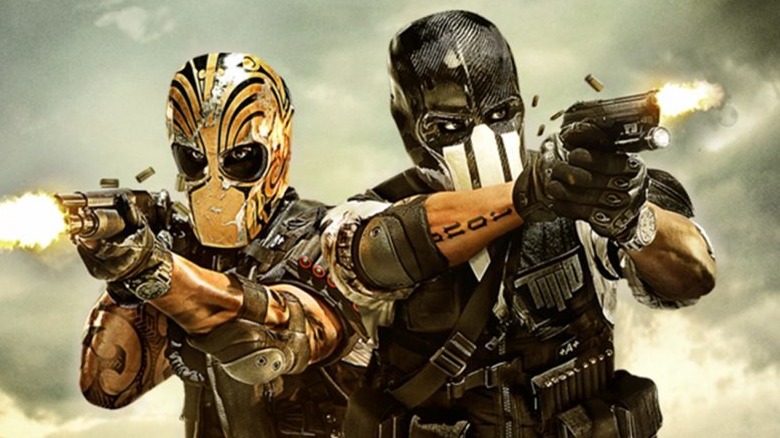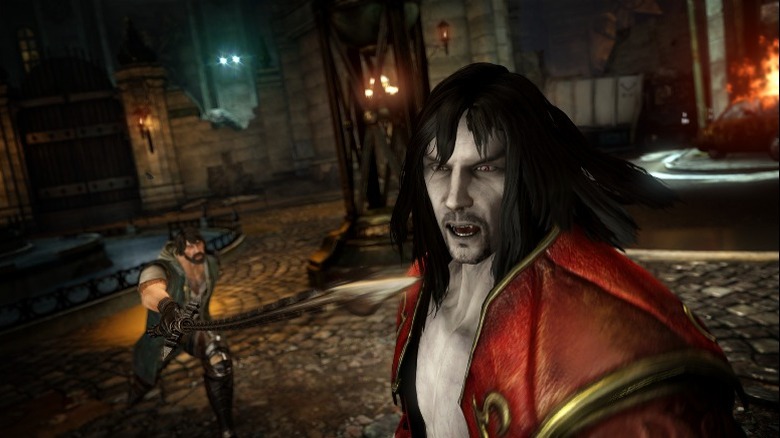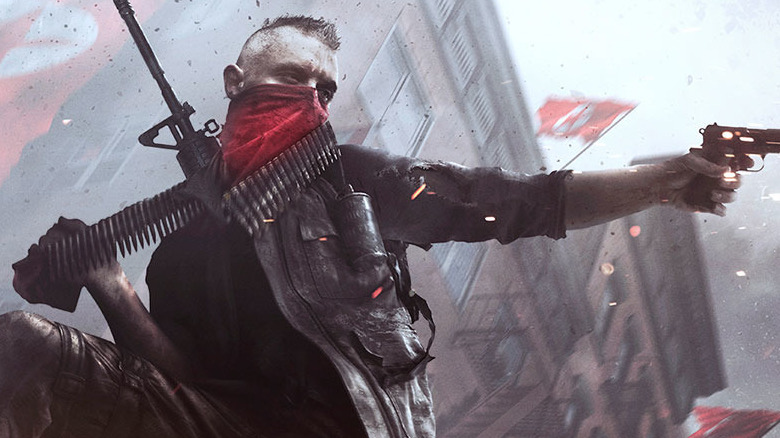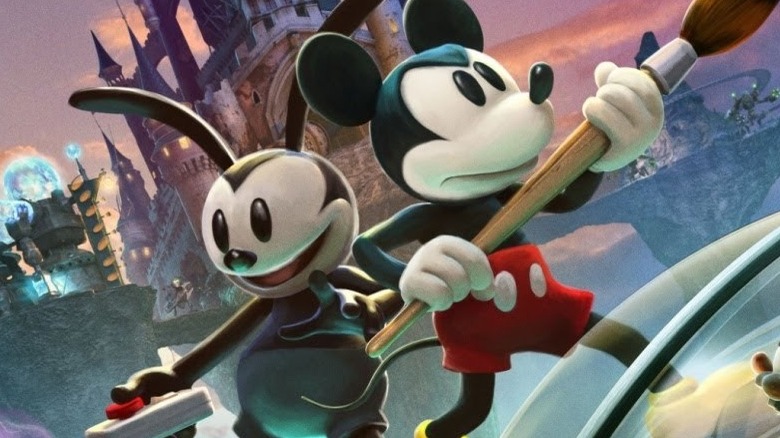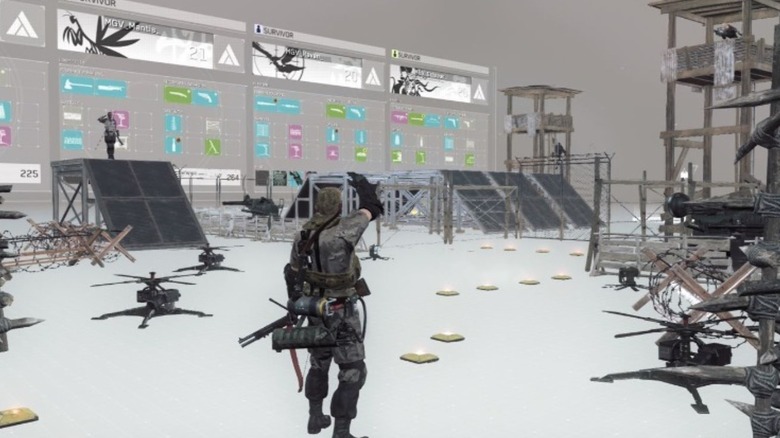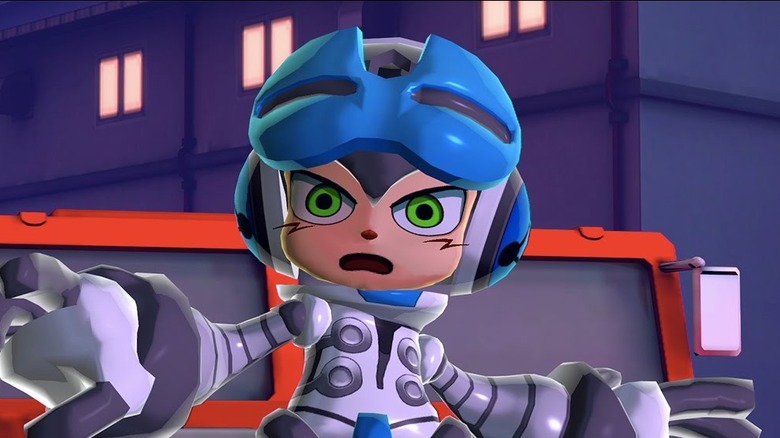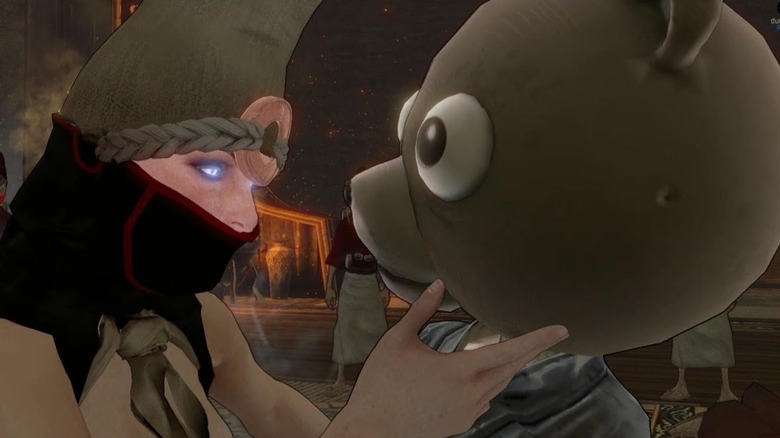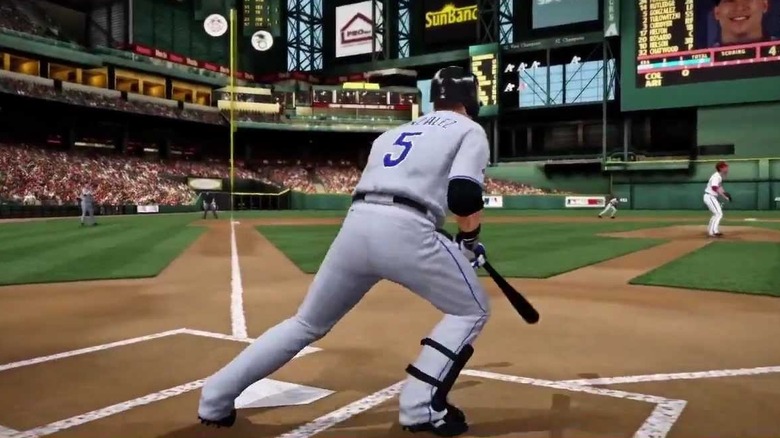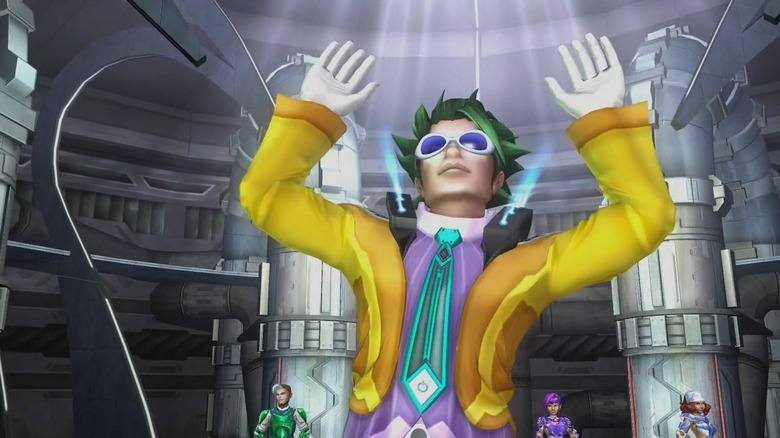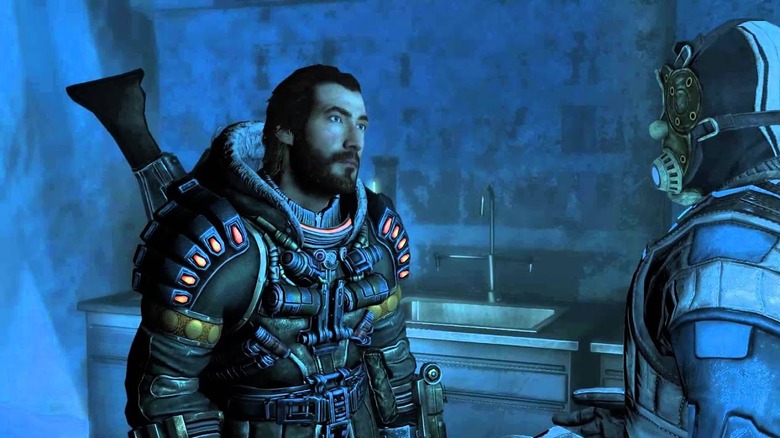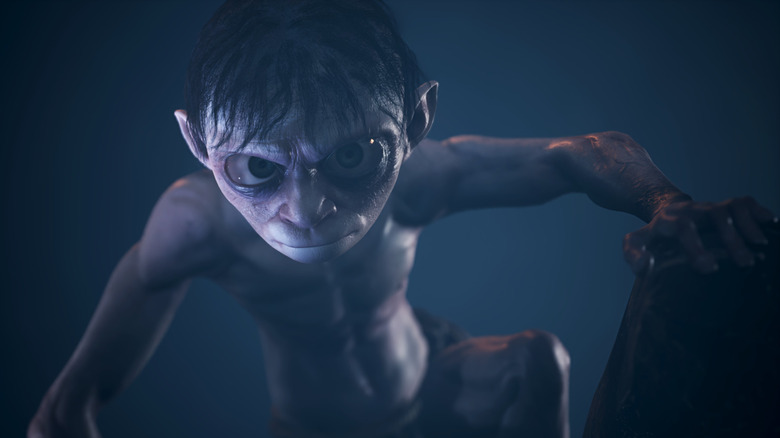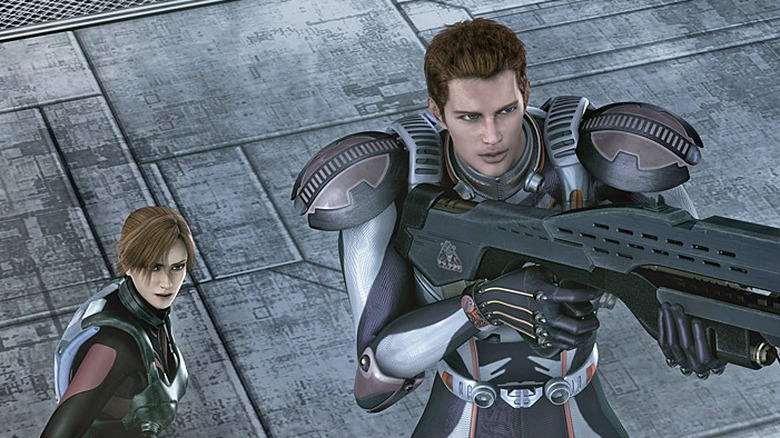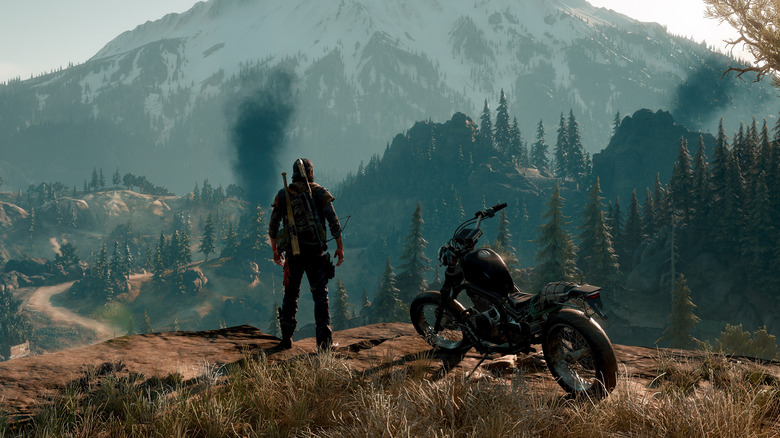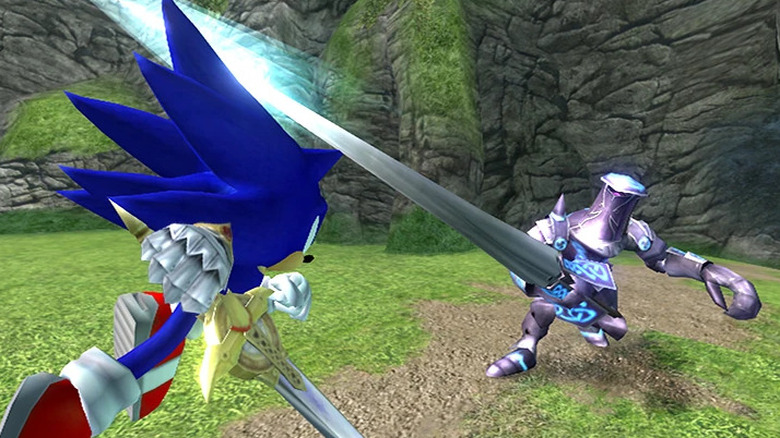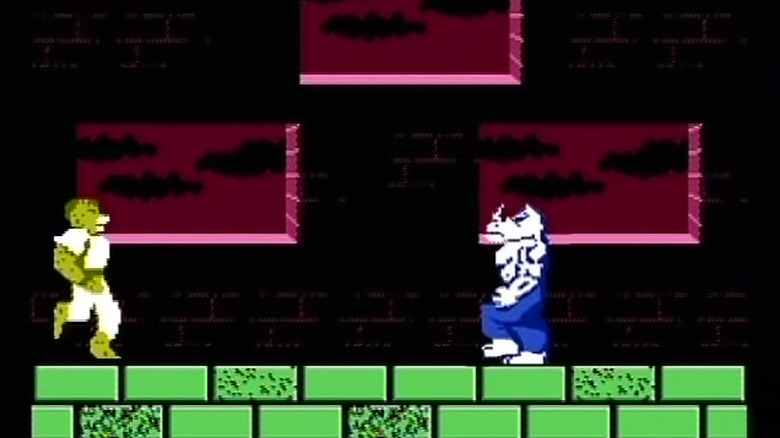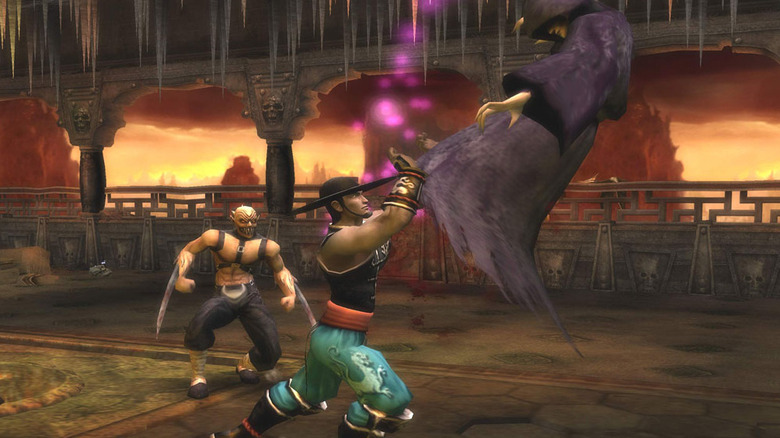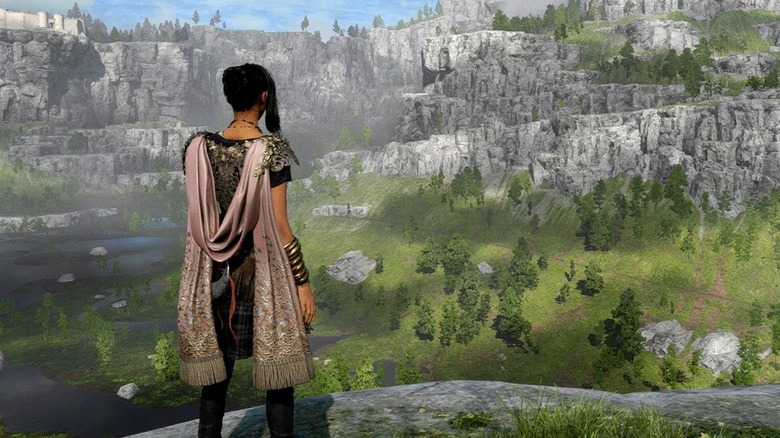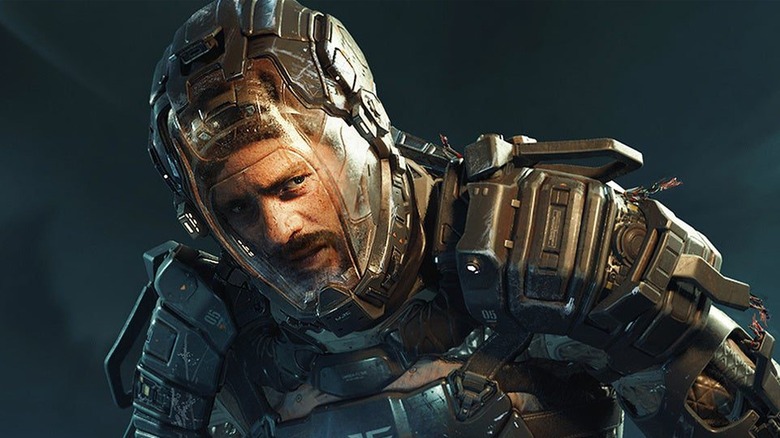Video Games So Bad They Had To Cancel The Sequel
In the modern era, video games are rarely, if ever, conceived of as one-off affairs. These days, nearly every title is developed with the hopes of it growing into a much larger intellectual property. And if a game finds any commercial success at all, it will almost certainly get a sequel. Often, that sequel is already in the conceptual stage before the first game even launches. Some new franchises even have multi-game arcs mapped out before work even begins on a prototype. Sequels, in other words, are in the industry's bones.
Of course, those hopes don't always pan out, and not every game meets with success — especially if it's just not very good. From veteran teams crashing on the shores of their own ambitions, to new developers who just couldn't get an idea to work at all, here are video games that turned out so bad, they had to cancel the sequel.
Too Human
In the late '90s, developer Silicon Knights wanted to create the next massive narrative epic, a game that would weave science-fiction aesthetics with Norse legends. The game would feature a huge world to explore, a rich mythology to discover, and a blistering blend of combat styles. Initially intended for the original PlayStation, the game would have to be split across four separate CDs, similar to other sprawling epics such as "Final Fantasy 7." It's fair to say that Silicon Knights had high hopes for the title.
But the game, called "Too Human," struggled from the start, as it suffered numerous delays and console switches, not to mention friction between the developer and engine-maker Epic Games. So once the title finally did release in 2008 for the Xbox 360, it really had to break out as a megahit in order to recoup both the coin and the expectations spent on it. Unfortunately, it did neither. Players found that combat had been simplified all the way down to the right analog stick, which couldn't provide enough options to hold their interest in the many combat encounters. Not that those encounters had any weight to them: death in the final release had no consequence at all. Players would simply resurrect on the spot, without losing any resources.
Reviewers were not kind, and gamers by and large gave "Too Human" a pass. Silicon Knights had hoped to create a full trilogy out of the IP, but with the critical and commercial failure of the product, the sequel never came to pass.
The Order: 1886
Sony's "God of War" franchise exploded in the mid-2000s into one of the company's signature hits, a PlayStation-seller that raised the third-person action genre to new heights. As the primary studio in Santa Monica got to work on sequels, a different developer, Ready at Dawn, was tasked with creating new "God of War" games for the PlayStation Portable system. After those games went on to commercial and critical success, the studio was at last ready to realize its ambitions: to create a franchise of their own. The first entry in this new IP was "The Order: 1886." Blending Arthurian mythology with a steampunk setting, "The Order" offered a unique setting along with plenty of action and intrigue. In a way, this was an expansion of the lessons the studio had learned from "God of War." With the level of graphical fidelity that always made Sony first-party games stand out, "The Order" was set to be the hottest new game in the PlayStation lineup.
But it wasn't. Reviewers skewered the game for being surprisingly limp to play and short to complete. Far from being the next "God of War," "The Order: 1886" became lost in the crowd, and quickly fell out of the gaming conversation. The rights to the series remained with Sony, which meant that even though Ready at Dawn was ready with more sequel ideas – a whole series, in fact — the franchise's fate was left in the publisher's hands. No word of any new installments have been spoken of since, and Ready at Dawn has moved on to other projects.
Dawn of War
Relic Entertainment is among the most prestigious strategy game creators in the business. "Dawn of War" and "Dawn of War 2 "were both successful games, but for very different reasons: in fact, though they shared the same title, the two games were nothing like each other. The first was a conventional base-building real-time strategy game, while the second was a squad-focused real-time tactics experience. So for the follow-up, "Dawn of War 3," Relic decided to combine both play-styles into one, while simultaneously incorporating ideas from the popular MOBA genre.
Like "StarCraft 2," "Dawn of War 3" featured three unique playable factions. These all included individual hero units with different abilities, which would center the battles around these characters from the narrative. However, that narrative proved to be weaker than in previous games, and the balance of army strategy and hero tactics simply never gelled into a solid game.
Relic's previous "Dawn of War" games all got massive expansion packs that were, for all intents and purposes, full sequels. They had entirely new campaigns and new units added to each factions' rosters. Dawn of War III had the same roadmap, but unfortunately, poor sales forced Relic to cancel any future work on the expansions. Their goal of crossing over MOBA, strategy, and tactics players ended up appealing to none of them, and now the title is dead. Where Relic goes from here is anybody's guess.
Duke Nukem Forever
It's true: "Duke Nukem Forever" took a very, very long time to release. Started way back in 1996, the game suffered endless restarts and directional shifts until, at long last, its developer 3D Realms went out of business. And yet, Duke lived! Gearbox Software, a studio known for, you know, actually finishing games, took on the project. They polished up what 3D Realms had done and formally launched the finished game in 2011.
The head of Gearbox Software, Randy Pitchford, explained that he "did not acquire the franchise merely so people could experience 'Duke Nukem Forever,'" which means that he wanted more "Duke" games down the road. But "Forever" was not a commercial success; in fact, it tanked hard.
Pitchford would later credit this to the fact that "Forever" had just trod the same ground that "Duke Nukem 3D" had decades earlier. Despite his wishes for a Duke-centered franchise, Gearbox hasn't announced any new games. "Duke Nukem" espouses a certain kind of masculinity that doesn't translate very well to the modern era: crass, womanizing, and unsophisticated. Maybe it's possible to evolve the character in some way that wouldn't alienate long-term fans, but honestly, we could be waiting a very long time for that. Maybe forever.
SiN Episodes
In the mid-2000s, a revolution struck the gaming industry: Steam, Valve's digital platform that was part-network, part-storefront, and part-DRM service. This allowed smaller developers to cut out publishers altogether and skip the expense of boxing and shipping physical products. Developer Ritual Entertainment also foresaw a whole new business model for gaming: instead of spending years creating one massive project, it was now possible to spend a fraction of the time making smaller, bite-sized 'episodes' of a single game that would be released over time. Ritual put their idea to the test and got to work on a follow-up to their 1998 shooter "SiN." The result was "SiN Episodes: Emergence," released in 2006 exclusively on Steam. Running on Valve's own Source engine, the game had the graphics and mechanics of AAA title, but produced for only a fraction of the budget.
Unfortunately, the game never caught on. Its design sensibilities were already out-of-date, and the first-person shooter genre had plenty of other options for buyers to choose from. In the end, "Emergence" only managed 150,000 sales, only barely enough to recoup the costs of development. Though Ritual had always intended to move on to the next episode, and the next, a second title never arrived. Shortly afterwards, Ritual was acquired by MumboJumbo, a spin-off company that had originally been part of Ritual itself. Since Ritual's new parent was a casual-focused company, many thought the "SiN" franchise might be put on hold. No official statement ever came, but no other "SiN" game has been seen since.
Call of Duty: Ghosts
Video game franchises don't come much larger than "Call of Duty." A success since the first game in 2003, the franchise leapt into genre-defining prominence with 2007's "Call of Duty 4: Modern Warfare." Ever since, "Call of Duty" games have released every year like clockwork. "Modern Warfare" became its own sub-brand within the series, but after making three of them, developer Infinity Ward was ready to move on to a new idea. The result came out in 2013 as "Call of Duty: Ghosts."
Set in a near-future riven by nuclear conflict, Ghosts introduced a team of covert operatives desperately trying to fend off an invasion of the United States by a coalition of South American nations. Featuring the fast-paced action and persistent multiplayer rewards that had turned "Call of Duty" into a juggernaut, "Ghosts" seemed like it would be a smash hit. And indeed, it was — but not by as much as in the franchise's past. The game had a paint-by-numbers feel to it, a sequel mandated by corporate need and not artistic passion — even more so than other "Call of Duty" games. After the disappointment of "Ghosts," a new narrative director was brought on-board, who had no desire to continue with any plans for a sequel. Instead, Infinity Ward started from scratch and created an entirely new game, "Call of Duty: Infinite Warfare," which was intended to be the new sub-franchise that "Ghosts" couldn't be.
Night Trap
In the 1990s, a new genre of video game was emerging. More interested in giving the player some control over the narrative rather than serving them constant action scenes, these games leaned into their cinematic influences by creating the entire game out of full-motion video, or FMV. FMV was, effectively, just recorded footage of actors, with the video quality kicked down to fit onto game consoles of the time. "Night Trap," a teen horror game where the player tried to defend some helpless coeds by springing traps on their assailants, became the most famous of this style.
But fame isn't always a good thing. "Night Trap" drew the attention of the United States Congress as parents began to realize how violent these 'kids' games' were getting. Under scrutiny, publisher Sega decided to pull the game from stores. Though "Night Trap" would eventually be ported to other consoles, the whole FMV genre waned over the next few years.
But the creators of "Night Trap" still believed in their vision, and twenty years later, a Kickstarter campaign tried to bring their game back to life. Part of their promise was an idea for a "Night Trap" sequel, which they hoped would energize their fanbase after so much time. But it didn't: the campaign barely made 10% of its financing goal.
Wet
Bethesda Softworks is the publishing arm of ZeniMax Media. They have released some of the biggest hits in history, including "The Elder Scrolls" and "Fallout" games. But these titles were all produced internally. In the late 2000s, Bethesda decided it was time to start publishing more projects developed from outside the company. One of their early pickups was a game called "Wet" from developer Artificial Mind and Movement, which had recently been dropped by its old publisher, Activision.
"Wet" was a kind of video game equivalent to the "Kill Bill" films: a bloody revenge story featuring a female lead equally adept at swords as she was with guns. Unfortunately for Bethesda, it turned out that Activision had dropped it for good reason. The game released to poor reviews, and its reception was hurt by its subpar graphics, relatively short length, and poor controls. Despite this, the studio was excited to announce a sequel was in the works in 2010. But simply put, nobody else shared their excitement. Bethesda later publicly stated that they would not be publishing the sequel, a strong indication that the original had sold poorly. Without commercial or critical success to buoy it, "Wet 2" has basically evaporated.
Army of Two: The Devil's Cartel
"Army of Two" always felt like a game forced into franchise status by publisher Electronic Arts, and not by any kind of audience demand. The first game never set the market on fire, and, if anything, it became something of a punching bag. The webcomic "Penny Arcade" took aim at it with a strip outlining when, and when not, to fist pound. And yet, the game became a series with the release of its sequel, "Army of Two: The 40th Day." Despite suffering many of the same issues — namely, that no one really cared — it managed to spawn a follow-up, "Army of Two: The Devil's Cartel," in 2013.
"The Devil's Cartel" seemed intensely aware that franchise heroes Salem and Rios had become bywords for glorified violence in video games. So this time around, developer EA Montreal (which technically reported to Visceral Games) decided to bench the main characters and send in two new characters instead. These characters were far less glib than their predecessors; unfortunately, this also meant they were far less interesting. In addition, EA Montreal removed the competitive multiplayer mode, which made the package feel incomplete. Plus, the AI simply wasn't very good.
"The Devil's Cartel" took a problematic franchise and made it boring instead. Is that better or worse? Answer: nobody cared. Receiving the worst reviews of the franchise so far, "The Devil's Cartel" marked the last entry in the "Army of Two" series, and no new game is in sight. Oh, and one other thing: EA shut down the Montreal studio altogether. That franchise isn't just dead, it's buried. Under concrete.
Castlevania: Lords of Shadow 2
"Castlevania: Lords of Shadow" was the pleasant surprise of 2010. A Westernized 3D update of the classic 2D series, "Lords of Shadow" married the gothic atmosphere and slick action of "Castlevania" with the close-up and fast-paced style of "God of War." What's more, Konami gave the development team a boost by bringing no less than Hideo Kojima into the mix. The result was a superlative action game dripping with fantastic art design. It seemed like the long-dormant "Castlevania" would at last rise from its coffin and sink its fangs into the modern gaming scene.
Then came "Lords of Shadow 2" in 2014. And, hoo boy: whatever secret sauce went into the first game had apparently dried up by the second. The game received virtually no promotion prior to its launch, itself a sign of trouble. The sequel had a different director, who allegedly was a nightmare to work for. And Kojima was not involved in any way this time. If that first game was lightning in a bottle, the sequel was a cold guy standing in the rain, holding up a bottle, hoping for lightning to strike twice. Needless to say, "Castlevania: Lords of Shadow 2" was butchered by critics. Since then, there's been no sign of another "Lords of Shadow" game. "Castlevania" is a beloved franchise, and may get another reboot someday. But the dream of a long-running, high-quality franchise that the first game promised was never realized.
Homefront: The Revolution
The original "Homefront" in 2011 was publisher THQ's attempt to cash in on the modern warfare craze inspired by "Call of Duty 4." Featuring a script written by "Red Dawn" writer/director John Milius (or, then again, maybe not), the game envisioned a future in which North Korea invaded the United States, and a rag-tag band of rebels rose up to defy the Communist occupiers. While reviews were only middling, the game did almost predict the death of North Korean dictator Kim Jong-il. So, there was that.
THQ greenlit a sequel, which sounds simple enough. And then, everything went wrong. First, THQ shut down developer Kaos; then they handed the reins over to Crytek UK; then THQ itself went under; then Crytek, still making the sequel, suffered financial problems and stopped paying its developers. Crytek shuttered its UK office and sold the unfinished game to Deep Silver, which then founded a new company and hired back all the laid off developers. Whew! After all that, you would hope that at least the resulting game would all be worth it. Sadly, no. "Homefront: The Revolution" was bashed by critics, even worse than the first game, all but assuring no sequel would ever follow.
Epic Mickey 2
The Walt Disney Company is a behemoth of the entertainment industry, which bestrides the Earth with franchise studios like Marvel, Lucasfilm, and Pixar. Yet once upon a time, Disney was most famous for a creation of the man himself: Mickey Mouse. In 2006, Mickey returned to screens in video game form in "Epic Mickey," a game designed by industry legend Warren Spector. For all the hype around the mouse's comeback, the final product didn't review all that well. Critics found it repetitive and shallow, despite the fantastic representation of early Disney charm.
Disney just wouldn't be Disney if it didn't knock out a sequel, and so "Epic Mickey 2: The Power of Two" arrived in 2012. Unfortunately, something clearly went wrong somewhere in development. The sequel suffered dismal reviews, since it fixed none of the issues with the first game and somehow managed to make the whole thing even less fun. Mickey Mouse and his friends might be great characters, but a bad game is simply a bad game. "Epic Mickey 2" is an object lesson in trying to coast off the strength of an intellectual property, and failing.
After disappointing sales of the sequel, Disney closed developer Junction Point Studios, and with it, any hope of an "Epic Mickey 3." Perhaps someday, Mickey Mouse will make a triumphant return and prove to the world why he built a little company into the greatest force in entertainment. Now that would be pretty epic.
Metal Gear Survive
From the release of the first "Metal Gear" in 1987 until the launch of "Metal Gear Solid 5: The Phantom Pain" in 2015, Hideo Kojima nearly always had a hand in the series. Unfortunately, that all changed when Kojima and the company he spent decades working for, Konami, had a very public breakup. After Kojima's departure from Konami, some wondered if there would ever be another "Metal Gear game," or if the fifth mainline entry was the last. There was also some concern about what a "Metal Gear" title without Kojima might look like, and as it turns out, that concern was well warranted.
"Metal Gear Survive" arrived in early 2018 as an attempt to combine the video game zombie craze with the "Metal Gear" license. The reviews were pretty poor, with "Survive" only managing to attain a Metacritic score of 60. Perhaps this title was an attempt by Konami to cash in on the "Metal Gear" name, and a way for the company to see how fans would react to a Kojima-less project. The answer: "Survive" is arguably the worst "Metal Gear" game ever, and may have destroyed the brand for good.
Mighty No. 9
"Mom, I want a new 'Mega Man' game!" the child exclaimed. "We already have 'Mega Man' at home," the mother replied, reminding the child about his unopened copy of 'Mighty No. 9.' Yes, it's true that "Mega Man" and "Mighty No. 9" are not part of the same franchise, and the only thing connecting them is legendary game designer Keiji Inafune. Still, those thirsty for a new entry in the "Mega Man" series had hoped "Mighty No. 9" would fill that void with some of the same platforming action.
Sadly, it wasn't meant to be. When "Mighty No. 9" released in the middle of 2016, it did so with a whimper, receiving a low score on Metacritic. Before the game's release, Keiji Inafune spoke optimistically about "Mighty No. 9" potentially becoming another "Mega Man" in terms of success and relevance. He wanted there to be more games after the first. Years later, a follow-up still hasn't materialized, and one can't help but assume that's because "Mighty No. 9" was such a disappointment.
Afro Samurai 2
The first "Afro Samurai" game wasn't terrible, per se. It certainly didn't make it onto a list of the games with the worst Metacritic scores. But something clearly went wrong when the sequel, released years later, changed both developers and publishers. "Afro Samurai 2" is a prime example of why that particular tactic is not a good idea, as fans likely had some expectations and those definitely were not met. "Afro Samurai 2" received some of the worst review scores on record, and there's nothing to indicate the game didn't deserve them.
"Afro Samurai 2" earned a dismal 21 on Metacritic, by far one of the lowest scores on the site. To make matters worse, what came out of "Afro Samurai 2" was just its first episode; there were supposed to be more on the way. After seeing how poorly the game was received by fans and critics, the team behind it cancelled all remaining episodes and actually pulled the game from sale entirely. When you consider the way "Afro Samurai 2" went out, it's tough to see a third entry coming to the series.
MLB 2K13
You could say a really good baseball game knocks it out of the park. It simulates all the action of the sport in the right away, and recreates the more managerial aspects with a great deal of realism. "MLB 2K13" could've been a champion: 2K's sports titles have often been praised for their quality, at least when taking on football and basketball. Unfortunately, that was not the case with baseball, as fans found out with "MLB 2K13."
"MLB 2K13" was a big swing and a miss, scoring a mere 48 on Metacritic while serving as the very last "MLB 2K" title ever released. There was never an "MLB 2K14," as 2K ultimately decided not to renew the "MLB" license, thus cancelling the series entirely. The move didn't do away with baseball video games entirely, as Sony's "MLB The Show" would go on to the tradition alive.
Fuzion Frenzy 2
The first "Fuzion Frenzy" is a sort of cult classic; a game that received average reviews but is often looked back on now as a favorite by many who owned an original Xbox. You may have fond memories of playing "Fuzion Frenzy" yourself, and may have wondered why Microsoft never tried to bring the franchise back. The game might find an audience in the present day, as titles like "Fall Guys" have brought multiplayer party games back to the forefront. There's a chance Microsoft is a bit gun shy, though, because of the "Fuzion Frenzy" sequel you may have never heard of.
Yes, "Fuzion Frenzy 2" was a thing — a 2007 release on the Xbox 360 that only managed to nab itself a 49 on Metacritic. While the first game was developed by Blitz Games, the second was developed by Hudson Soft and wasn't nearly as well received. Microsoft is apparently so intent on forgetting about "Fuzion Frenzy 2" that the company opted not to make it backward compatible on newer Xbox consoles, despite offering compatibility for the first release. If you never get another new "Fuzion Frenzy" game again, you may have "Fuzion Frenzy 2" to blame.
Lost Planet 3
Some trilogies are all around solid. Some start out with two strong entries and then falter on the third. Those usually aren't deal breakers for the future prospects of a franchise; at the time of this writing, there are new "Mass Effect" and "BioShock" titles in the works. If a trilogy starts out okay and gets progressively worse, though, it may end up getting the axe the way the "Lost Planet" series seemingly has.
The first "Lost Planet" dropped with decent review scores. The second entry, "Lost Planet 2," lost some ground and came in lower as a result. The third game, "Lost Planet 3," sank all the way down to a Metacritic score of 58 and may have pulled the potential for newer entries down with it. Because "Lost Planet 3" came out in 2013 — and because Capcom hasn't uttered a word about the franchise since — it's probably a safe bet that the reception for the third game killed "Lost Planet" off for good.
The Lord of the Rings: Gollum
"The Lord of the Rings" franchise has an undeniably strong fan following that has permeated wider pop culture. From Peter Jackson's award-winning film adaptations to beloved video games like "Middle-earth: Shadow of Mordor," fans of Tolkien's fantasy world have lucked out in other mediums. Unfortunately, 2023's "The Lord of the Rings: Gollum" did not come close to meeting those standards.
Plagued with delays throughout development, "The Lord of the Rings: Gollum," a third-person action RPG, was initially supposed to release in 2021. However, delays over the next two years trashed those plans. Daedalic Entertainment, the developer behind this dud, claimed extra time was needed to make the game's best version possible. Well, the studio probably needed even more time.
What ended up releasing to the public on May 25, 2023, was nothing short of a disaster. Critics widely panned the game's uninspired gameplay and its technical issues, with some calling it the worst game of the year. Autosaves and puzzle areas were just as likely to break as they were to complete. The most glaring problem is that the graphics look more appropriate for a mobile game, not a current-gen title. The difference between the game's graphics from its early advertising to actual gameplay is substantial.
Following the disastrous release of "Lord of the Rings: Gollum," Daedalic Entertainment announced plans to shut down its game development wing to instead focus solely on game publishing. This announcement also made it clear that the company had canned another "Lord of the Rings" game Daedalic Entertainment had in the pipeline. One of the most cursed games of 2023 will never get the intended follow-up.
Dino Crisis 3
In the late 1990s, Capcom was on top of the world. The developer/publisher had just released a hit survival-horror game, "Resident Evil," and looked towards expanding that proven formula with a new IP. That is why the original "Dino Crisis," directed by "Resident Evil" maestro Shinji Mikami, was created. The game gained fans and positive reception from critics due to its wacky story, exciting characters, and novel environments mixing sci-fi and dinosaur-driven action.
"Dino Crisis 2," released in 2000, took the series down a slightly different path. Instead of following in the survival-horror footsteps of its predecessors, "Dino Crisis 2" opted for more of an action-adventure experience with the same continuing characters. The release of "Dino Crisis 3" in 2003, however, spelled the end of the once-beloved franchise.
Two major issues worked against "Dino Crisis 3." First, the game ignores the storyline and characters from the previous games, even with the cliffhanger ending from "Dino Crisis 2." Even more annoying, the third game's horrible camera system made gameplay more difficult than it should have been, earning the title "The Worst Camera Ever" from IGN.
Despite these shortcomings, preliminary production of "Dino Crisis 4" quickly got underway, according to an interview with Capcom's General Manager, Yoshiki Okamoto. However, "Dino Crisis 4" still hasn't come out, making "DC3" a bonafide series killer.
Days Gone
"Days Gone" is a 2019 action-adventure RPG developed by Bend Studio set in a post-apocalyptic zombie world led by a motorcycle-driving protagonist. The game began development in 2015 and was unveiled at E3 2016. Throughout its production, Bend Studio reportedly expanded its development team from 50 to around 130 members to accommodate its growing scope.
The game's open-world design provided the means for generating atmospheric exploration, but reviews panned the game's open world for its filler content that pushed players to do repetitive tasks all over the map. Criticism was also pointed toward the game's unpolished stealth mechanics and occasionally clunky shooting. Despite these mixed reviews, "Days Gone" went on to sell decently well. It was the 19th best-selling game in the US in 2019, and it has gone on to generate a cult following.
Bad news struck fans of the game when, in 2021, Bloomberg News reported that Sony had rejected a proposed sequel, which would have reportedly supported a co-op shared universe. In an interesting turn of events, the game's writer/co-director, John Garvin, implied in an interview that "Days Gone" didn't get a sequel because too many people bought the game on sale, instead of snagging it at launch.
Sonic and the Black Knight
Sega's friendly mascot, Sonic, is well-known for his acclaimed platforming titles, flash game spin-offs, and even his own big-budget movies. However, even longtime fans of the "Sonic" franchise might have forgotten about a series of spin-offs called the "Sonic Storybook Series." Ever wondered what Sonic might look like in classic mythological settings?
The first game, "Sonic and the Secret Rings," released for the Wii in 2007, places the titular character in the world of "Arabian Nights." As is the case in every other "Sonic" title, the name of the game is collecting rings. However, the method of collecting said coins is much less exciting in this installment. Movement in the game happens automatically, forcing players forward on a rail and only giving controls to attack or move left/right across the screen to avoid obstacles.
Even after "Sonic and the Secret Rings" collected poor reception, its sequel, "Sonic and the Black Knight," was developed and released on the Wii in 2009. The same problems plagued this "Sonic Storybook Series" sequel, which sported bland gameplay within a weird mish-mash of settings. Unfortunately, not even a sword-wielding Sonic could save the sub-series' fate. A community poll ran after the release of "Sonic and the Black Knight" to help choose the next game's setting. Greek Mythology won the vote, but nothing further emerged from the "Sonic Storybook Series."
Cheetahmen
In the early 1990s, Active Enterprises made and a compilation multi-cart called "Action 52." Released for the NES in 1991 and the Sega Genesis in 1993, "Action 52" was advertised as housing 52 different games for the low-low cost of $199. Unfortunately, nearly every game was unplayable due to bugs, and "Action 52" has gone on to be known as one of the worst video games of all time. Even so, one game on "Action 52" stood out. The 52nd game, in fact: "Cheetahmen."
"Cheetahmen" was the only original game on the multicart. It featured three half-cheetah-half-man characters, each named after a Greek god. In what can only be described as a half-baked side-scrolling platformer, "Cheetahmen" feels like a fever dream. Much like the rest of "Action 52," its levels and controls are wonky and riddled with bugs, but at least it's playable. It even had a somewhat coherent storyline for players to follow. Its zany aesthetics and lo-fi execution has subsequently inspired a cult following, despite its quality. And would you believe there were two sequels planned?
Its first sequel, "Cheetahmen 2," never officially released. In 1996, however, 1,500 copies of it were suddenly rediscovered and sold through secondary markets. Unfortunately, much like other "Action 52" joints, "Cheetahmen 2" is unplayable due to its copious bugs. Even less is known about "Cheetahmen 3." It was planned as a release for the Action Gamemaster, a handheld multicart system like the GameBoy that was never actually produced by Action 52.
Mortal Kombat: Shaolin Monks
"Mortal Kombat" is no stranger to spin-offs, but quality hasn't always been assured. The franchise's first few attempts at action-adventure games, 1997's "Mortal Kombat Mythologies: Sub-Zero" and 2000's "Mortal Kombat: Special Forces," didn't go so well. "Mortal Kombat: Shaolin Monks" fared slightly better, but still didn't blow the market away upon its release in 2005.
Set after the first "Mortal Kombat" game in the timeline, "Mortal Kombat: Shaolin Monks" is a multi-directional side-scroller in which players have to defeat enemies using fluid combos, marrying beat-em-up gameplay with traditional "Mortal Kombat" moves. Players can also use combos to build up their Fatalilty meter and unleash devastating finishers. The game was received decently by critics and fans, though it was noted that it didn't reach the heights of the main series. Still, development began on a sequel.
However, in early production, plans for the sequel — codenamed "Mortal Kombat: Fire and Ice" — were shut down after it was determined that the game would cost too much to make and too long to complete. planned sequel featured Scorpion and Sub-Zero as main characters. Unfortunately, even though there are calls to continue the series, this series of "Mortal Kombat" spin-offs met its end. It seems the damage done by the preceding games was too great.
Forspoken
"Forspoken" is a sprawling fantasy RPG developed by Luminous Studios and released by Square Enix in February 2023. The game is a piece of entirely original IP, and though it borrowed plenty of action game combat mechanics that we've seen in the past, it also introduced some fun new magic and mobility skills. In SVG's review of "Forspoken," we noted that the parkour-like movement and fantasy combat sometimes come together to create spectacular moments, but the game as a whole is held back by an approach that's just a bit too by-the-numbers.
Most gamers were too put-off by the game's lackluster story, repetitive missions, and empty open word. People just didn't latch onto the appeal of a big Square Enix RPG, and that general lack of enthusiasm massively affected the game's sales. Just two months after the game debuted, Square Enix announced that it was shutting down Luminous and absorbing the studio into the rest of the company. At the time, Luminous was in the early development stages of other projects, one of which was planned to be a "Forspoken" sequel. Obviously the studio never made it that far, but it did get to release a DLC called "In Tantra We Trust" in May 2023.
The Callisto Protocol
"The Callisto Protocol" failed to capture the magic of "Dead Space," but it certainly wasn't for lack of trying. The game had the involvement of "Dead Space" creator Glen Schofield, and everything from the art direction to the combat mechanics were designed to be a spiritual successor to that beloved franchise. Considering how beloved "Dead Space" is, "The Callisto Protocol" could have been an easy slam dunk, but unfortunately the game fell flat on its face.
The biggest problem facing the game on release was its performance. Unsurprisingly, PC gamers got the worst of it, and many didn't stick around for patches to fix the buggy mess that was the release version of the game. Players who didn't push through the game found that "The Callisto Protocol" didn't have an engaging combat system at all. There weren't enough weapon or enemy types, and combat tends to be slow and sluggish. "The Callisto Protocol" flopped, and in an interview with Rock Paper Shotgun, Schofield shed some light on what really went wrong with the game. According to him, the studio was hammered by Covid, and its publisher pushed forward the release date by more than three months to hit the December 2022 sales window. Schofield said that he had some plans for where the story would go next, but "The Callisto Protocol 2" isn't going to get the green light.

